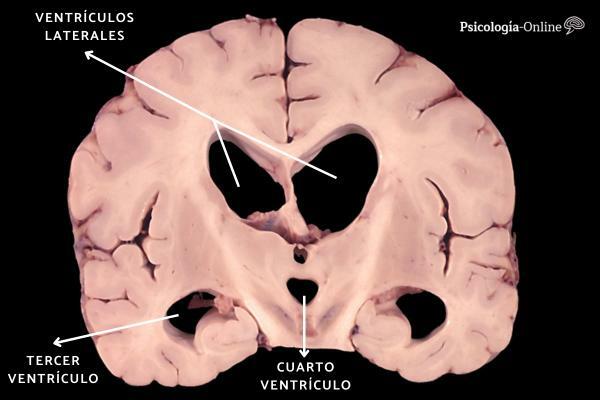
“… The individual did not dare to cross a bridge, pass near a reservoir or rock or remain in a beamed room, lest he might be tempted to hang, drown, or rush. If he was before a silent audience, such as in a sermon, he feared that he might speak out loud. loud and uncontrolled indecent and foul words... "Robert Burton .:" The Anatomy Melancholy ", (1883).
In this PsychologyOnline article, we will talk about the Review of current treatments for Obsessive Compulsive Disorder (OCD).
Index
- Introduction.
- Psychological treatment of OCD.
- Pharmacological treatment of OCD.
- Comorbidity or overlap of symptoms.
- Thanks
Introduction.
Compulsive-Compulsive disorder according to the DSM-IV-TR, (American Psychiatric Association, 2000), can manifest itself in any of the following ways and defines its components as:
- Obsessions are unpleasant and disgusting, unacceptable or meaningless, imagery thoughts or intrusive impulses that the subject tries to reject.
- Compulsions They are behaviors that the subject emits to neutralize the obsessive content of their thoughts and that operate in a similar way to avoidance or escape; that is, relieving underlying anxiety and discomfort by a pure process of negative reinforcement.
The age of onset of OCD It can range from infancy to age 40, with the highest frequency of onset going from early adolescence to early twenties. (Cruzado, 1998), and its “lifetime” prevalence ranges from 1.9 to 2.5% of the population (Karno et al., 1998).
People with OCD often they tend to have more than one type of obsession and compulsion, approximately 60% according to Foa and Kozac 1996, among other authors; being the most common:
1.-Pollution ideas: such as the fear of being infected by contact with elements such as blood, door handles or doorknobs, use of public toilets, sick people, etc... In these cases the most common ritual or compulsion is usually to wash repeatedly, (even lacerate the skin), shower frantically, wash dishes or clothes during hours…
2.-Ideas or fears of self-injury or aggression towards others: feel the impulse to jump off a bridge, attack their relatives with a knife...; As rituals, you avoid being alone with them, seeking re-assurance that no harm has occurred.
3.-Obsessions on religious aspects: such as blasphemies, doubts about whether they have sinned, or whether they have fully confessed, etc ...
4.-Obsessive ideas about order: perform tasks according to a certain sequence, count steps, or go up and down arithmetically ...
5.-Checking obsessions and rituals: how to continually check if the car, the gas tap or the door of the house has been closed properly ...
They are some of the most frequent that we can observe in the clinical practice of Psychology.
Obsessive-compulsive disorder owes its peculiarity in our judgment to four very important factors, namely:
- The difficulty of explain to the patient what his disorder consists of and its solution, (and even more so to their relatives or relatives);
- In connection with the above, the strangeness it can pose to the people you interact with the person affected her ritualistic behaviors; Unlike other anxiety problems, in which the escape or avoidance of the anxiety stimulus or situation is more understandable;
- The intervention techniques that we clinicians use (at least those of cognitive-behavioral orientation), in some cases even reckless or "strange" for the layman, for the treatment to be effective;
- And as a corollary, the fact of being one upset -As some authors indicate- "on horseback" between what were once called "neuroses" and psychoses; which would lead us to a certain extent to accept as good the Freudian hypothesis of the existence of a continuum, at whose poles or extremes the two mentioned entities would be located.
Psychological treatment of OCD.
Leaving aside techniques, procedures or approaches to the treatment of the specifically cognitive problem such as the new TRIP (Danger Ideation Reduction Therapy) or cognitive-behavioral packages, which do not add anything new to exposure techniques, unless the disorder occurs in the form of pure obsessions with compulsive behavior unobservable or covert, we can affirm, according to incontrovertible data from meta-analytic studies, (systematized reviews on the results of the effects of a certain treatment), that the technique of choice today for Obsessive Compulsive Disorder and in terms of efficacy, effectiveness and efficiency criteria, is “exposure with response prevention”.
After finishing the treatment, this exclusively behavioral technique was associated with a more marked overall improvement than with medication (which we will mention below). That is why it should be the first line of intervention for most of the cases, using the combination with drugs for the most severe ones, or for when there is a comorbidity with major depression or other associated disorders. These strategies consist of exposing the person to objects, people or images that cause anxiety and obsessions, preventing you from performing the neutralizations (compulsions or rituals) that decrease your anxiety (prevention of exhaust), e.g. contaminating you with a dirty object or possible germs and preventing you from showering or washing your hands for long periods of time. (This would be done for example also for a TOC with contamination ideas, which are otherwise the most common).
Anyway, this is just an isolated example, since the treatment is more complex, in addition to including other strategies that would also involve family members.
Also used is "Imaginary exposure": when the content of the obsessions is not accessible, when the patient reports an excessive fear of catastrophic consequences if not carries out neutralization or when obsessions are made up of images rather than situations, stimuli or events external.
A more complex case for treatment (that is why we will entertain ourselves a bit in it), consists of "Obsessions occur without overt compulsive behavior"; since avoidance and compulsions occur almost entirely in a covert way, which is why they are confuse obsessions with neutralizations, which come out in the form of brooding or rumination mental. When this happens, techniques such as “training in habituation and thinking stop ".
The "Habituation training" consists of the patient writing down the obsessive thoughts repetitively or deliberately recalling the obsessive thought (s) and keep this in mind until your therapist instructs you to do so (generally taking as a criterion, that subjective anxiety units -USAs- in a fear thermometer p. ex. are reduced to half minus one of their initial value, which can range from 0 to 100, or that they decrease by at least 50% of said value).
Another strategy for this and, which we especially like to put into practice, -as Foa and Wilson indicate in their now famous book- (Foa and Wilson, 2001), is that of record on cassette (if possible with hearing aids and with the patient's own voice) anxious thoughts that later he listens at the same time that his thought is following the tape. This method is especially useful since as Cruzado says (Cruzado, 1998), "... this method ensures that thinking occurs with maximum predictability and therefore will ensure habituation ..."
Regarding the training in the stopping or stopping of thinking, we can ignore it or not pay much attention to it since there are no studies –except for error- that have included a control group in their designs. Roughly, the patient must make a list of obsessive thoughts and another with alternative pleasant thoughts. The therapist first and then the patient, describe the obsession, which when it has been maintained in the mind a predetermined time, both can shout aloud a "stop", "stop" or "stop" which will then be done internal. The thought will then have disappeared, and the subject must then imagine the alternative scene. It is not idle to remember that in these lists, neutralizing thoughts should not be included.

Pharmacological treatment of OCD.
Traditionally obsessive compulsive disorder has been treated by psychiatrists with Clomipramine (Anafranil). An antidepressant of the tricyclic family that has powerful actions on the inhibition pump of the reuptake of a neurotransmitter called serotonin, however affecting in turn other brain neurotransmitters that have nothing to do with activity therapy. It is still used today for severe and refractory cases. Due to its cardiotoxicity and other side effects, other drugs began to be used from the second half of the 1990s. antidepressants, which did have a "quasi" -pure selectivity on said neurotransmitter, thus avoiding the side effects that the antidepressants possessed. tricyclic. The family of those cited (SSRIs) are: Fluoxetine, Fluvoxamine, Sertraline, Paroxetine, and Citalopram. Later, a brother of the latter called Escitalopram, active metabolite of racemic citalopram.
The latest meta-analyzes (again) tell us that Paroxetine, Sertraline and Clomipramine are the drugs of choice today to treat this disorder. Now, as we have said that they have side effects, it is convenient to administer them together with an anticonvulsant (GABAergic type or benzodiazepine) that increases the seizure threshold as well as to control to some extent the stimulation caused by the administration of the drug.
Also affect human sexual response (anorgasmia in women and delayed ejaculation in men), as well as mild and transient gastrointestinal disturbances like nausea and constipation. Reversible when the treatment continues, or when it stops.
Doses should be increased from 10 to 10 mg. for paroxetine for example, (the tablets are usually 20 scored), for sertraline and clomipramine 25 mg increments would suffice. respectively, due to the possible appearance of panic symptoms in predisposed people or with a history of their presence. Likewise, the dosage and duration of the treatments should be somewhat higher than that used for the major depressive episode; as also happens, for generalized anxiety disorders, social phobia and panic with agoraphobia in the which doses and time of drug administration should also be greater than for the disorder depressant.
Other drugs used in the T.O.C. and obsessive ideas have been neuroleptics such as Risperidone, Haloperidol, Olanzapine, or Levomepromazine, (especially if there is some schizoid trait or strong overrated ideas), as well as the whole range of Benzodiazepines available in the market, recommending those with a long half-life (preventing the accumulation of levels active principle), and discouraging those that could have a more disinhibitory effect than others; such as bromazepam, alprazolam or clonazepan against chloracepate, which does have this effect, with the subsequent counterproductive effect for the patient, which may consist of an increase in obsessions / compulsions when being uninhibited.
Comorbidity or overlap of symptoms.
Some patients with TAG (generalized anxiety), with panic disorder with or without agoraphobia, or with any other anxiety disorder, and / or depression, may present obsessivoid symptoms in the course or context of their clinical picture, and usually before any stressful event.
Unlike patients with OCD, people with generalized anxiety and / or panic perceive their anxious or anxious thoughts as relatively real but they rarely perform rituals to ease their anxiety; This is what leads clinicians to have to "spin very fine" when making the differential diagnosis, since it could be confused with a lot of easily one disorder for another with the consequent error in choosing and also applying the treatments, although in some respects they resemble a little.
When an OCD picture itself has not yet been consolidated, some strategies or indications such as the ones that follow may be sufficient for the subject. to alleviate (in mild cases, of course), obsessive symptomatology; as Professor Cruzado (1998) reminds us again, these are:
1º.- Thinking negative things does not mean that a person wants them. Thoughts are different from actions. Many patients believe that if a negative thought enters their mind, it immediately means that they want that bad thing to happen. That's not true. (This is what is known as magical thinking).
2º.- We all have thoughts that would embarrass us if the others knew; of all kinds, religious, sexual, etc... and in some cases, impulses to harm themselves or others.
3º.- You have to think that the content of obsessions is irrational. You have to tell yourself: "I am having an irrational, exaggerated and nonsensical thought", "It is the result of the anxiety problem that I have, it is an obsession".
4.- Instead of trying to stop thinking, it is more appropriate accept that you are having an obsessive thought or image which is what is causing your anxiety, in short, "It's about exposing yourself" to that thought, idea or image.
5º.- After carrying out the exhibition three or more times the degree of discomfort at the beginning of the next session will be less. This is the best indication that the treatment is working.
6º.- In the cases of exposure in imagination Include thoughts of disastrous future consequences that cause fear, anxiety, or distress.
7º.- Long exposures are more effective than short, interrupted expositions. Although the anxiety or anguish is high, it usually dissipates after approximately thirty minutes. Exposure should be continued as long as anxiety remains high and until it drops at least -taking as a criterion- one-half minus one of the scale from 0 to 10 that is already known.
8º.- If there are several sources of anxiety or distress the exposure treatment should be directed to the main obsessive thought, after which the second in importance is approached by alternating the treatment of both obsessive ideas or images.
9º.- Examples of positive self-instructions faced with an obsession or obsessive idea could be: “I am having an obsession, I must not avoid it, I must continue exposing myself, the more I expose myself the sooner I will end it, I can face it”; "This is the peak moment, if I hold on a little longer this will start to decline"; "Nothing worse can happen to me, I am doing what I have to do, which is to expose myself to this absurd obsession".
Thanks.
(*): I would like to express my sincere gratitude to Mª. Teresa and Juanjo Pérez Marín, Raúl Valiente López and Eva Mª. Pérez Agulló; as well as the teachers, Fco. Xavier Méndez Carrillo and José Olivares Rodríguez. They will all know why.
(**): Fco. Javier López González is a clinical and health psychologist (Graduated from the UNED), exercises his clinical-professional activity in Alicante and Province (Spain), is a doctoral student in Medicine, and is Professor / Teacher of Psychopathology and Psychological Treatments of the "Virtual Campus", as well as General and Applied Psychology at the "OASI" Training Center for bodyguards and security guards. Private security.
He is a specialist in Psychopharmacology and currently conducts his research on anxiety disorders and schizophrenia.
This article is merely informative, in Psychology-Online we do not have the power to make a diagnosis or recommend a treatment. We invite you to go to a psychologist to treat your particular case.
If you want to read more articles similar to Review of current treatments for Obsessive Compulsive Disorder (OCD), we recommend that you enter our category of Clinical psychology.
Bibliography
- American Psychiatric Association (APA, 2000). Diagnostic and Statistical Manual for mental disorders (fourth edition, revised text). (DSM-IV-TR). Washington, DC: Author.
- Azzam, A., Mathews, CA. (2.003). "Meta-analysis of the association between the catecholamine-O-methyl-transferase gene and obsessive-compulsive disorder". In: Am J Med Genet B Neuropsychiatr Genet. 2.003. Nov 15; 123, (1): 64-9.
- Ballesteros, S. General Psychology II. "A Cognitive Approach". (1.994). Madrid. Editorial Universitas S.A.
- Bellloch, A.; Sandín, B. and Ramos, F. Manual of Psychopathology Vol. II. (2.002). Madrid. McGraw-Hill Interamericana of Spain.
- Bottle, C. and Robert, C. "Obsessive-Compulsive Disorder", in Belloch, Sandín and Ramos. Manual of Psychopathology Vol. II. (1995) Madrid. McGraw-Hill Interamericana.
- General Council of Official Associations of Pharmacists, (2002). Madrid. "Catalog of Pharmaceutical Specialties". Author
- Cruzado, J A. "Obsessive-Compulsive Disorder" (1998), in Vallejo, M.A. Behavior Therapy Manual. Madrid Edit. Dykinson-Psychology.
- Low cut, A. "General History of Drugs" second edition (1999). Barcelona. Edit. Espasa Calpe S.A.
- Faus, G. "OCD?" 100 most frequently asked questions. (1998), Madrid. Editores Medicos S.A. (EDIMSA).
- Foa, E., Wilson R. "Overcome your Obsessions." A revolutionary method to free yourself from your obsessive behavior (2001). Barcelona. Edit. Robin Book Self Help Successes.
- Freeston, M.H., Rhéaume, J. and Ladouceur, R. (1996). "Correcting faulty appraisals of obsessional thoughts." Behavior Research and Therapy, 33,: 433-446.
- Freeston, M.H., Ladouceur, R., Gagnon, F., and Thibodeau, N. (1991). “Cognitive intrusions in a non clinical population. I. Response style, subjective experience, and appraisal ”. Behavior Research and Therapy. 29,: 585-597.
- Labrador, F.J., Cruzado J.A. and Muñoz, M. "Manual of Modification Techniques and Behavior Therapy". (1999). Madrid. Edit. Pyramid.
- Macià, D., Méndez, F.X., "Clinical Applications of Behavior Assessment and Modification." Study of cases. (1997). Madrid. Edit. Pyramid.
- Rachman, S. Obsessions, responsability and guilt. Behavior Research and Therapy, 31,: 149-154.
- Salkovskis, P.M., Warwick, H.M.C. (1985). "Cognitive Therapy of obsessive-compulsive disorder: Treating treatment failures." Behavioral Psychotherapy, 13: 243-255.
- Stahl, S.M. "Essential Psychopharmacology" (2002). Barcelona. Edit. Ariel Neuroscience S.A.
- Vallejo, J., Berrios, G. "States Obs.


